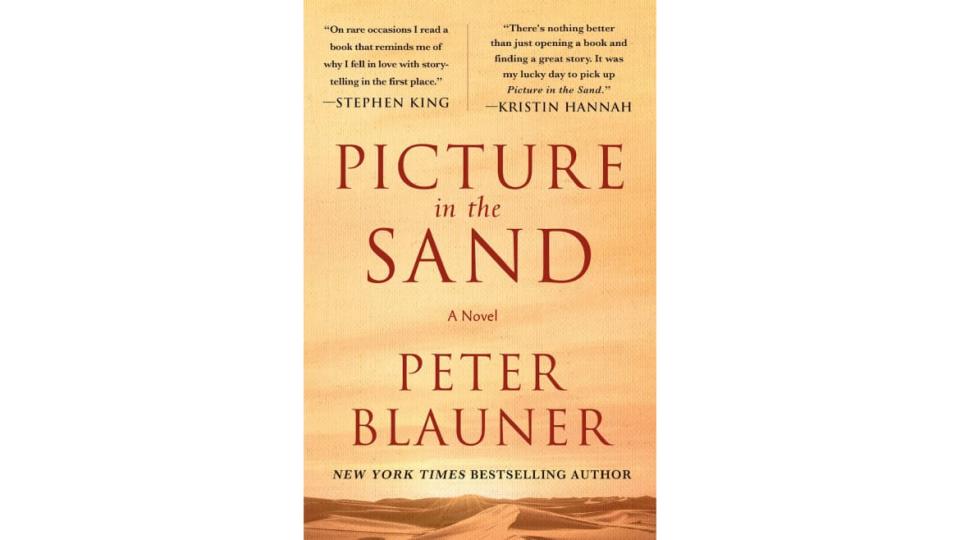Did Events in Gaza Just Rewrite My Historical Novel?

- Oops!Something went wrong.Please try again later.
“I feel terrible about what I’m about to say to you,” the woman in the audience told me. “But I have to be honest.”
That’s rarely the start of a conversation that ends well, whether it’s a first date or a book talk. But it was a Jewish Cultural Center event and I was an invited guest speaker. The subject was my historical novel, Picture in the Sand, in which the protagonist is a young Egyptian movie fan who gets drawn into a terror plot involving the Muslim Brotherhood and political violence.
“I would have read your book in one way before October 7,” the woman said in a measured tone. “But it was hard for me to read it now. Because you’re asking me to feel compassion for someone I do not wish to feel any compassion for.”
I didn’t think I had written anything particularly controversial. Or rather, I thought this novel would be less controversial than the ones I’d written about racial tension, raw sex, and confused liberals. This one was set in 1954, so who was going to be upset? I wasn’t thinking about current events in Gaza. I was thinking about the real-life connection between Cecil B. DeMille, the Egyptian Revolution, and religious fanatics. I’d learned the legendary filmmaker shot part of The Ten Commandments in Egypt just as fundamentalists were battling military strongmen for control of the country. I thought this delirious collision of larger-than-life personalities would make for a rollicking historical novel. I thought it was all so long ago that it could even seem… fun.
Boy, did I have another think coming. I realized my book might not be as innocent as I initially thought, because in the deeply divided world we live in now, even historical novelists need to keep looking over their shoulders. Reality may be catching up with them.
Of course, writing about current events in fiction has always been dicey. Back in 1961, Philip Roth said that the modern author had “his hands full in trying to understand, describe and then make credible much of American reality. It stupefies, it sickens, it infuriates and finally it is even a kind of embarrassment to one’s own meager imagination.”
But what’s going on right now is a little different. The past no longer offers any refuge for novelists seeking relief from the present. And I’m not the only one who’s noticed. Last summer, Elizabeth Gilbert, the mega-successful author of Eat, Pray, Love, announced she was “indefinitely” delaying the publication of her new novel, set in Siberia in the 1930s. The reason? A massive swarm of trolls on Goodreads had attacked her for daring to write anything about Russia while war was raging in Ukraine.
You can argue that Gilbert could have stood her ground and told the trolls to go play in traffic. But this was not an isolated controversy. In a New Yorker article last year, Elif Batuman questioned whether it was possible to read the works of Tolstoy, Pushkin, and Dostoyevsky without considering the context of the current war. PEN Ukraine called for “a total boycott of books from Russia in the world!”
Elizabeth Gilbert’s Delay of Russian Novel Baffles Book World
In the United States, writing about history has become just as fraught. The 1619 Project, created by Nikole Hannah-Jones and published as an essay collection by The New York Times, before being marketed as a school curriculum, helped ignite long-simmering debates about the legacies of the Civil War and slavery.
Conservatives angered by Critical Race Theory discussions have sought to control how antebellum narratives are imparted. Florida has even instituted school standards that stress to students some people learned “useful skills” from their enslavement.
In this climate, even novels like To Kill a Mockingbird, once a staple of school reading lists, have come under new scrutiny. Published in 1960 and set during the Depression, Harper Lee’s novel was listed as number five on The New York Public Library’s 2020 “Top Check Outs of All Time.” But lately the tide has turned. Last year, the Washington Post reported that students and teachers in a Washington state school district demanded the book be stricken from required reading lists for its use of racial epithets and its centering of “whiteness.” Others questioned why a novel by a white author was being used as a teaching tool for lessons about racial justice.
On the other hand, Joshua Cohen’s Pulitzer-winning 2021 novel, The Netanyahus, a seriocomic fable about the future Israeli prime minister’s family making a disastrous visit to an American college campus in 1959-60, has only gained in stature and prescience because of the news in the last few months.
So, what to make of all this? Evelyn Waugh once wrote, “We possess nothing certainly except the past.” But how do you write about the past when the common ground we stand on isn’t settled, and history keeps intruding on the present?
I’ve certainly gotten the long view wrong myself. Back in 1988, when I was a young reporter for New York magazine, I was given the opportunity to write a full-issue oral history of the city’s previous 20 years. I was given license to interview anyone I liked about politics, real estate, media, sports, and entertainment. I talked to people like Mickey Mantle, Ed Koch, Betty Friedan, Abbie Hoffman, Steve Rubell of Studio 54, David Dinkins, Diane Von Furstenberg, and Rudy Giuliani.
You know who I didn’t talk to?
I had his phone number on my Rolodex, but instead I called Al Goldstein, editor of Screw magazine, the Bible of the sleazy Times Square porn scene. The reason? I’d interviewed Trump a couple of years before and thought he had less substance—and less moral fiber—than Goldstein, who was at least an authentic sleazeball. I didn’t want to be part of the hype machine. And I was dead wrong.
Trump turned out to be one of the most significant historical figures to emerge from New York City—even though his misadventures with Stormy Daniels and others have more in common with the pages of Screw than the diaries of John Quincy Adams.
So, I thought long and hard before I answered the woman at the Jewish Cultural Center event. And I realized the seeds of controversy might have been present from the moment I conceived of the book—which happened about 7:09 p.m., March 27, 2002.
I remember the exact date and time because it was the first Passover after 9/11. Urgent questions were still in the air about why the planes struck the towers. The Ten Commandments was on TV. I’d seen the parting of the Red Sea at the end a hundred times. But this time I saw it from the beginning and discovered from the credit roll that the pharaoh’s army was played by the Egyptian First Cavalry. That meant there was an unlikely connection between Hollywood and Al Qaeda. Because much of the group’s ideology was inspired by Sayyid Qutb, a leading intellectual in the Muslim Brotherhood, who was in Cairo, fulminating against the West, while Charlton Heston and Cecil B. DeMille were just a few miles away making a sword-and-sandals Bible epic for Paramount Pictures.
Maybe I was crazy, but I thought there was storytelling gold in them hills.
Twenty years later, I was still searching for it.
Part of the difficulty I had was in answering a basic question: What did this old story have to say to people alive now? At first, the reply seemed obvious. Cecil B. DeMille was still famous, Qutb’s name was frequently mentioned in connection to 9/11, and people still remembered Gamal Abdel Nasser, the military strongman who agreed to let DeMille shoot his movie in Egypt. But the longer I worked on the book, the more those names became lost in the sands of time. By the time my agent presented a version to publishers in 2013, many editors no longer recognized those names. The novel did not find a home and that seemed to be the end of the story.
But during the pandemic, I decided to try one more time. September 11 was no longer a key reference point for many readers. I realized I needed to find a new angle. I got rid of the original American protagonist and made a minor character named Ali Hassan the focus of the book, even though some people told me that was a cultural and commercial risk. Just as important, I structured the book as a kind of modern epistolary novel, with Ali as an old man sharing his secret story of his involvement with Hollywood and terrorists with a grandson who has decided to forgo a scholarship to an Ivy League school to go overseas and fight for ISIS instead.
This version of the book eventually found a publisher, at Minotaur/St. Martin’s Press. But while I was rewriting it, the ground shifted yet again. ISIS began to fade into history after its leader Abu-Bakr al-Baghdadi had died during a raid by US Special Forces. I made some very minor adjustments and the book was finally published in January, 2023. Fourteen months later (coincidentally, the week the paperback edition was published), a group calling itself ISIS-K attacked a concert hall in Moscow and killed 137 people.“Given everything that’s happened since then, are you sorry now that you wrote it?” the woman at the JCC asked me.
Well, no.
I guess it might have been wiser, and more profitable, to write pure escapism. But like a lot of other authors, I didn’t get into the business strictly to get into business. That’s just as well, because a novel like Picture in the Sand was never going to be a surefire money-maker. But the things that made me want to write the book—faith, hope, terror, and the movies—are as relevant now as they were in 1954. And if the novel made some readers uncomfortable because it presented a character like Ali compassionately in the post-October 7 era, so be it. Wars come and go, perspectives change, and history gets rewritten to suit the times. But the human heart is always the human heart.
Seventy-four years ago, William Faulkner wrote, “The past is never dead. It’s not even past.”
That’s as true now as it was then. Only maybe more so.

Peter Blauner is the author of nine novels. Picture In the Sand is his first work of historical fiction.
Get the Daily Beast's biggest scoops and scandals delivered right to your inbox. Sign up now.
Stay informed and gain unlimited access to the Daily Beast's unmatched reporting. Subscribe now.

